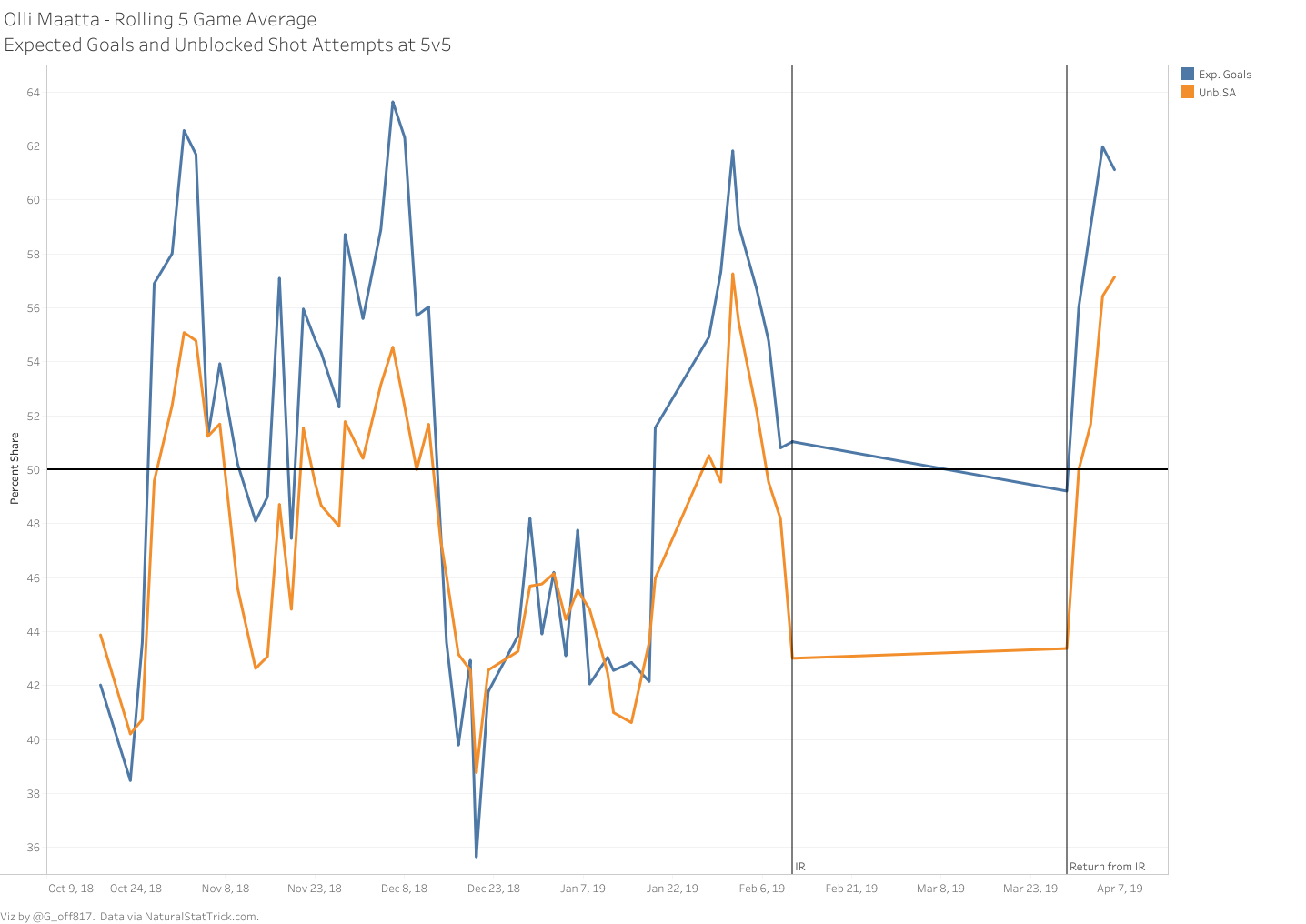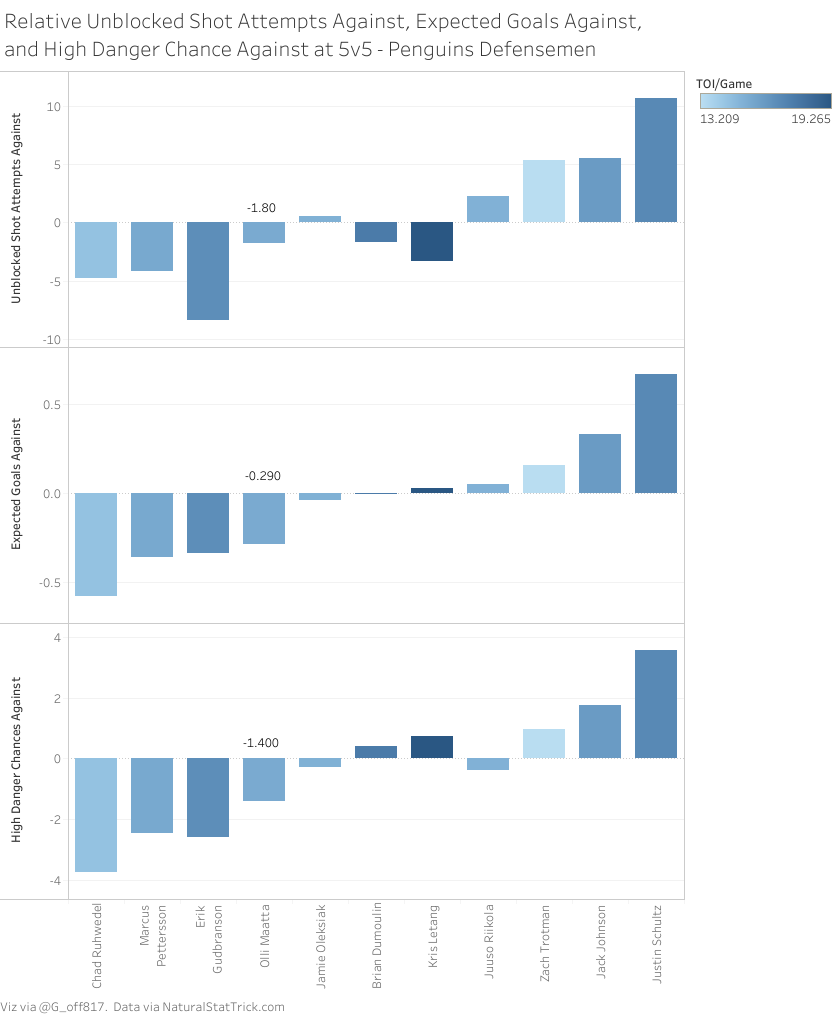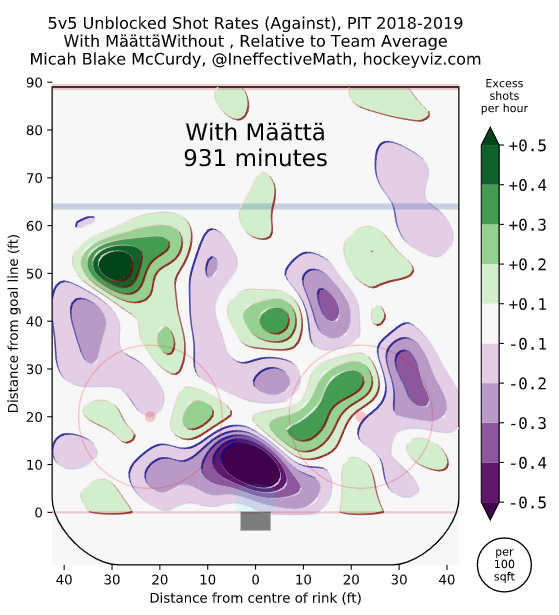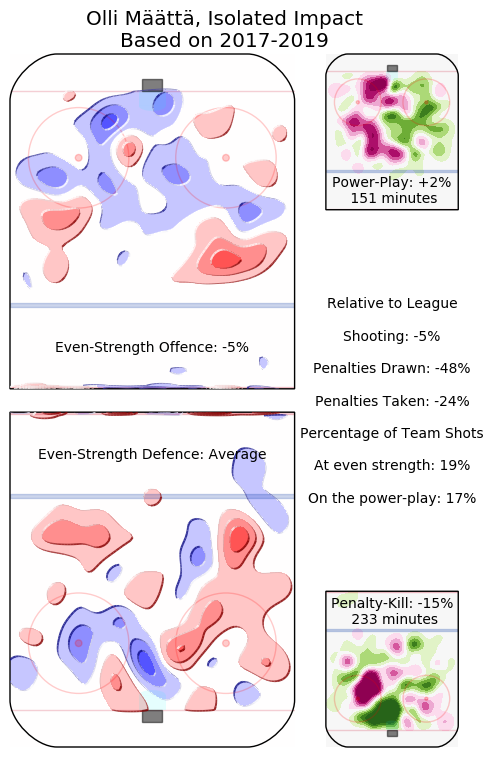Aside from Phil Kessel, one name that is pretty consistently mentioned as Trade Bait for the Penguins this offseason is Olli Maatta. Whether it be TSN’s list, The Athletic’s list, or practically anyone on or off line, Olli Maatta’s name is there as someone that may get moved this summer.
You’d be hard-pressed to find anyone that doesn’t at least find this a little bit understandable. Maatta is coming off an up-and-down season where he was limited to just 60 games after sustaining an upper-body injury in February and, following a disastrous Game 1 on Long Island, he didn’t see any playoff action in Games 2, 3, and 4 as HCMS opted to roll out an equally disastrous Jack Johnson.
Just how up-and-down was it? Well…
Maatta’s (and Johnson’s) lack of foot speed, too, was a serious problem and frequently on display for the Penguins. Via Craig Custance with The Athletic in the Trade Bait Board linked above, he had this to say (emphasis my own):
20. Olli Maatta, Pittsburgh Penguins – GM Jim Rutherford has to do something to fix the Penguins’ defense with Maatta and Jack Johnson both candidates to be moved. The problem, besides Johnson’s contract, is that injuries have slowed down Maatta. “I think that holds him back now,” said an NHL scout. “I don’t think he’s a very good skater.”
The upside with Olli Maatta of course is that he’s still only 24, on an affordable contract that pays him $4,083,333 each of the next three seasons, and showed at times this year that he can certainly play and eat serious top 3/4 minutes. From late November/December, following Riikola’s stint in the pressbox (seen as the big spike up that peaks on 12/6 above):
https://twitter.com/G_Off817/status/1069258042896801794
And when Maatta himself returned from injury for the last 5 games of the regular season, he was far and away the best Penguins defensemen over that stretch at 5-on-5 in the 83:57 he played.
| Olli Maatta – 5v5 | Shot Attempts | Unblocked Shot Attempts | Shots On Goal | Goals | Expected Goals | Scoring Chances | High Danger Chances |
| Percent Share | 57.76% | 57.14% | 62.11% | 75.00% | 61.02% | 58.44% | 61.29% |
Naturally, sample size is important to consider here. The above sets combined represent about 168 minutes of his total 927:15 of 5v5 play (~18%), but there are still some positives to take away from that in spite of the fact that his overall season shares of shot attempts (46.51%), unblocked attempts (48.41%), shots on goal (48.75%), and scoring chances (48.56%) all fell short of the 50% threshold.
This, too, without mentioning that his on-ice goals for share (53.75%), expected goals share (51.53%), and high danger chances share (53.71%) all exceeded the 50% line at 5v5, or that his actual vs. expected goals largely exceeded expectations (43 for vs. 36.47 expected//37 against vs. 34.31 expected), or that he exists in the “Good” realm with respect to his rates of expected goals for and against.

These sub-50% shares, however, can be a bit misleading in Maatta’s case.
Because, while yes, Maatta was on the ice for more of those events against than he was for, it was Maatta’s defensive prowess in his own end of the ice that was a huge positive for the Penguins this season, as we can see in the clips below.
https://gfycat.com/alienatedblackandwhitegypsymoth
Here, Maatta is tying up and taking away Anders Lee in front as a point shot comes in from a December shootout win against the Islanders. Rather than chasing the rebound that DeSmith kicks out to Nelson, Maatta considers his options and lets DeSmith make the secondary save. If Maatta leaves Lee, Nelson feeds him and it’s a tap in. But as soon as Nelson collects the second rebound and moves behind the net, Maatta knows he has support from Crosby and Oleksiak and engages with Nelson, breaking up the pass and allowing the Pens to take it the other way.
A week prior to this, Maatta again was showing up with some great defense in a 6-3 win over the Avalanche, where his play at one end of the ice immediately paid dividends with a goal at the other end.
First, Maatta plays a big role in chasing Matt Calvert behind the net, keeping his stick and body engaged with the Avalanche forward before stealing the puck and breaking it up ice.
https://gfycat.com/desertedfantasticazurewingedmagpie
Maatta would go on to join the attack, eventually setting up Brassard for a goal 35 seconds later on an elegant and heady shot-pass to fool both Calvert and Soderberg.
https://twitter.com/G_Off817/status/1070112354694766592
The final play that’s worth considering is what he did in a February 5-4 loss to the Lightning, the game just before he got injured.
Here, it’s again a play that immediately results in a goal for the Penguins (and Garrett Wilson’s first NHL goal). Watch Maatta here as the Bolts enter the zone and the textbook way Maatta defends the zone entry.
The clips starts when Maatta is cheating over to the strong side to support Riikola in the event that the Lightning skate the puck in. It effectively would’ve allowed them to squeeze the wall and force a turnover. Instead, the Bolts move it to the open ice on the near side to get into the zone.
But this is where Maatta shines: preventing players from attacking the middle of the ice. Because for as much as he doesn’t have the speed to cope with players driving wide on him, he doesn’t allow them to get to the danger zones.
https://gfycat.com/speedydistinctdogwoodtwigborer-the-pensblog-lightning-penguins-wilson
He does that exact thing here, keeping the Lightning forward to the boards, eventually running him to the corner and out of real estate. This gives the Penguins, who have the numbers advantage here, time to get back and support him as the Bolts look to move the puck back to the point.
Maatta continues to keep the wall locked down and keep the puck from ending up in the corner, eventually leading to Blueger and Cullen stealing the puck, marching up ice and Wilson burying the 2v1.
This affinity for defending well shows up in the data too.
Let’s start with looking at his Goals Above Replacement (GAR), visualized by Sean Tierney below using Evolving Hockey’s GAR model.
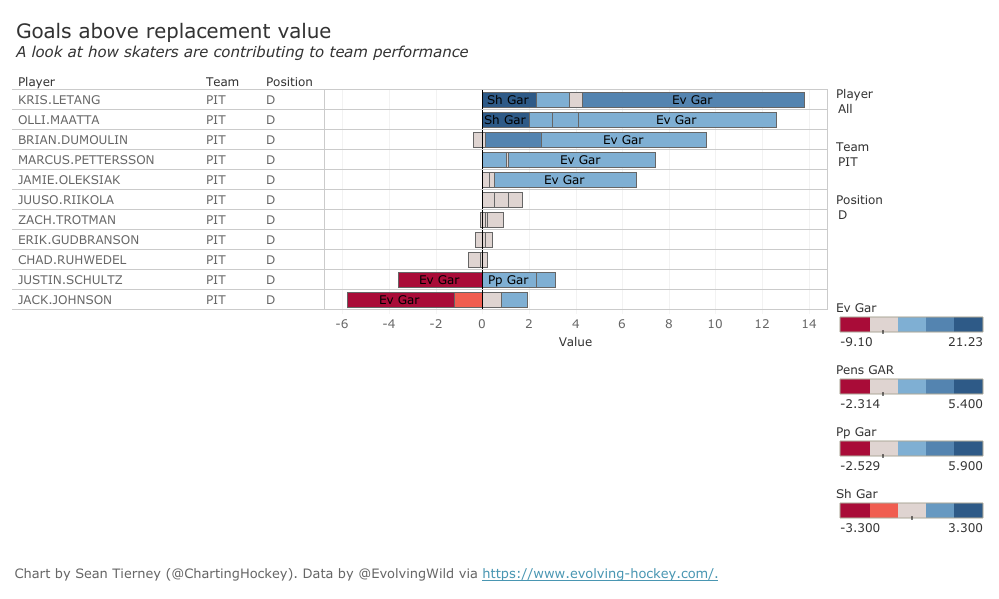
Finding yourself sandwiched in between Letang and Dumoulin in any contributing category is usually a good sign and that’s precisely where Maatta found himself here.
But where Maatta really starts to sing defensively comes when looking at the data relative to both the Penguins and the league. First, the Penguins:
So, what we can see here is that, relative to the rest of the Penguins, Olli Maatta stacks up pretty well defensively. The Penguins give up 1.8 fewer unblocked shot attempts, 0.29 fewer expected goals, and 1.4 fewer high danger scoring chances with Maatta on the ice versus when he’s off of it.
Across the board, only Ruhwedel (18 games played), Pettersson, and Gudbranson consistently saw the Penguins give up fewer while on the ice than when they were off of it.
This impact shows up in the excess of unblocked shot attempts against being deep, dark blue below (via HockeyViz.com), illustrating just how much the Penguins don’t give up high danger shots against from the doorstep with Maatta on the ice relative to the rest of the team.
And when we look at Maatta in the context of the rest of the league, we see how much he held his own as well. Let’s start by looking at HockeyViz.com’s 3-year Isolated Impact.
Over the last three seasons, Maatta finds himself right around average in terms of his even strength defense. What’s encouraging, though, is all of that blue in the mid-to-low slot, just as we saw above. That means, while Maatta is on the ice, teams are getting fewer unblocked shots against the Penguins from those areas relative to the rest of league.
Unfortunately, the same holds true in the offensive zone, where the Penguins are a -5% threat versus the league average and generally get unblocked shots from lower danger areas with Maatta on the ice, though you’ll see in a second that this was somewhat of the opposite case this past season.
On the positive side of things again, just how good is the Penguins PK is with Maatta? With Maatta on the ice on the kill, the opposing powerplay is a -15% threat relative to the league average, where all of that green directly in front of the net means fewer shot attempts are being taken from that area.
Again, it’s objectively good that fewer unblocked looks are being had from the area Maatta typically occupies.
The same holds true when looking at the 5v5 on-ice unblocked shot rates occurring when Maatta is on the ice this past season, relative to the league (again via HockeyViz.com).
Despite the Penguins generating 5.14 fewer unblocked shot attempts with Maatta on the ice this season than when he was off of it, relative to the rest of the league, the Penguins are still on the positive side of the “Threat” measurement as they generate well above the league average from down low in front of the net with Maatta on the ice (as well as an excess of unblocked shots from the left point, where Maatta lives).
But perhaps more importantly is Maatta’s impact in the defensive zone.
Overall, the opposition is a -6% Threat when Maatta is on the ice, making them less of a threat to score on the frequency of their shots. Impressively, though, is the cover provided to the Penguins goaltenders from all three slot regions.
In other words, the deep blue from the low slot up to the high slot means that when Maatta is on the ice, teams playing the Penguins are generating fewer unblocked shot attempts from those high scoring areas.
Again, this is extremely good.
Now, some caveats to this commitment to defense do exist though. For the Penguins, a team that struggled to defend last season, it’s great to have a defender that is capable of actually defending, particularly when the defending is as good as Maatta’s was last season. Sacrificing some attacking push doesn’t necessarily have to be a bad thing so long as the puck is still going in the net at one end and staying out at the other.
It can, however, be a bad thing when two of your 3 pairings don’t move the puck in a positive direction, as was the case for the first 55 games of Maatta’s season.
Effectively, it meant that Letang and Dumoulin exclusively had to do almost all of the heavy lifting in moving the puck forward because the other two pairings, Maatta’s and Johnson’s in this case, were not getting it done.
Fortunately for Maatta, he’s generally been in being on the ice for these “For” events over his career in the categories mentioned earlier where he fell short of the mark:
| Maatta – 5v5 (Per Hour) | 2018-19 | Career |
| Unblocked Shot Attempts For | 40.44 | 42.97 |
| Share of Unblocked Attempts | 48.41% | 51.19% |
| Shots on Goal For | 30.28 | 32.13 |
| Share of Shots on Goal | 48.75% | 51.90% |
| Scoring Chances For | 25.17 | 26.51 |
| Share of Scoring Chances | 48.56% | 51.56% |
And should the Penguins hold on to him and find that he rebounds to a level much closer to his career average while building on his great defensive season this past year, they will surely be better for it.
Note: All data provided by Natural Stat Trick unless otherwise noted.
Add The Sports Daily to your Google News Feed!

